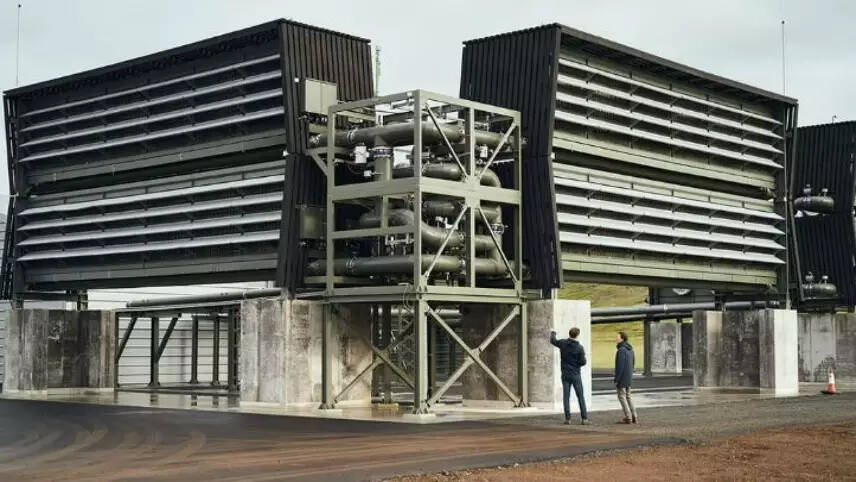Register for free and continue reading
Join our growing army of changemakers and get unlimited access to our premium content

Image: Climeworks. Pictured: The firm's new 'Orca' direct air capture plant in Iceland
Published by BeZero Carbon, a ratings agency for voluntary carbon offsets, the report forecasts that carbon credits generated by man-made carbon removal technologies will account for 56% of the overall voluntary carbon market within ten years, up from 19% at present.
This forecast is based on the growing interest in offsets from man-made removals from the private sector, despite most of the key technologies not yet existing at commercial scale. 89% of credits sold for carbon removal tech over the past 12 months have been for “future” offsetting, the report notes.
Corporates to have announced support for man-made carbon removal tech in 2022 include McKinsey & Company, Meta (formerly known as Facebook), Shopify, Stripe, and Google’s parent company Alphabet. Inc.Collectively, these five firms have pledged to purchase $925m of credits.
The BeZero Carbon report notes that the cost of offsetting using tech-based options is currently far higher than investing in nature-based offsets, or offsets which contribute to the uptake of renewable electricity or cleaner cooking fuels. Currently, capturing a tonne of CO2 using direct air capture will cost at least $320 and as much as $2,050, BeZero Carbon Claims.
The report highlights that this cost will come down as technologies scale up – but that coordinated financial action from the private and public sectors, as well as supporting regulation, will be needed. It highlights the potential benefits of introducing a regular auction scheme, modelled on the UK’s contracts for difference (CfD), for carbon removals, to help bring down the cost curve.
BeZero Carbon recommends collaboration to bring the cost of one tonne of offsetting via direct air capture down to $100m by 2030, in order to scale global carbon removals to the extent needed in a net-zero world by 2050. It claims that up to 10 billion tonnes of carbon removal capacity will need to be brought online by 2050 if net-zero is to be delivered using a higher-emission pathway which relies more on the ‘netting’ than the emissions reduction. At present, that would cost some $8.5trn per year.
For context, the collective capacity of all operational carbon capture and storage (CCS) and carbon capture and utilisation (CCU) facilities in 2020 has been estimated at 38.5 million tonnes.
Bringing down the cost of emissions removal technologies, the report emphasises, cannot be done using a race-to-the-bottom approach, in which technologies which do not deliver their promised climate benefits are supported to grow.
The report states that improved accreditation methodologies will need to be explored and developed “at a pace” to ensure that emissions removals are actually happening. Methodologies should also be shared globally to avoid an ‘alphabet soup’ situation of conflicting accreditation standards. The report additionally recommends that, as the carbon removal market scales, credits should be delivered after the removals have taken place – not before, as is the case for most purchases now. This will help to improve credibility.
“As the Intergovernmental Panel on Climate Change (IPCC) has set out, there is a 50% chance we do not hit our climate targets even with enormous amounts of carbon removal,” said BeZero’s head of carbon removal Ted Christie-Millier. “There is no time to waste. We need to drastically reduce the price of carbon removal over the next decade. The public sector cannot do this alone. We need to harness the power of the market to bring costs down and allow these new and emerging technologies to scale up.”
The report is being supported by MP Chris Skidmore, the Conservative MP for Kingswood and chair of the All-Party Parliamentary Group on the Environment.
However, not all MPs are so supportive of man-made carbon removal technologies. A letter published by MPs on the cross-party Environmental Audit Committee (EAC) in March, produced following consultations on these technologies, urges Ministers to do more to ensure that high-emitting companies strive to reduce their emissions footprint before using negative-emissions technologies as a ‘get-out-of-jail-free’ card.
Particular concern was expressed by the EAC about the fact that, ultimately, we do not know whether some nascent technologies will be able to credibly deliver their foreseen climate benefits at scale, making them a riskier choice than proven solutions.


It’s not just about carbon though is it?
Whilst removing carbon from the atmosphere will be crucial in reducing the effects of climate change this will do nothing to arrest the unsustainble use of resources, combat the loss of biodiversity and habitats, loss of soil fertility, increasing pressure on water resources, plastic pollution, chemical pollution, contaminated land and water, poverty, inequality etc.etc.
Sustainability is about so much more than reducing carbon emissions or removing emissions already emitted, from the atmosphere.
It is about a fundamental systemic change, how we use resources, what we use them for, consumerism, capitalism, built-in obselescence, waste, greed, inequality, corruption etc…